Altai Republic
The Altai Republic (/ˈæltaɪ/; Russian: Респу́блика Алта́й, romanized: Respúblika Altáy, pronounced [rʲɪˈspublʲɪkə ɐlˈtaj]; Altai: Алтай Републик, Altay Republik)[11] is a federal subject (a republic) of Russia. It is geographically located in the West Siberia region of Asian Russia, and is part of the Siberian Federal District. The Altai Republic covers an area of 92,600 square kilometers (35,800 sq mi) and has a population of 206,168 (2010 Census), the least-populous republic of Russia and federal subject in the Siberian Federal District.[6]
Altai Republic | |
|---|---|
| Республика Алтай | |
| Other transcription(s) | |
| • Altai | Алтай Републик |
| • Kazakh | Алтай Республикасы |
 Flag 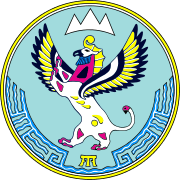 Coat of arms | |
| Anthem: National Anthem of the Altai Republic | |
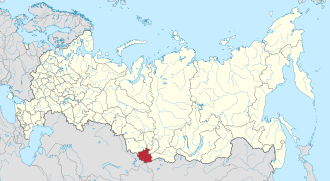 | |
| Coordinates: 50°55′N 86°55′E | |
| Country | Russia |
| Federal district | Siberian[1] |
| Economic region | West Siberian[2] |
| Established | July 1, 1922 |
| Capital | Gorno-Altaysk |
| Government | |
| • Body | State Assembly—El Kurultai[3] |
| • Head[3] | Oleg Khorokhordin[4] |
| Area | |
| • Total | 92,600 km2 (35,800 sq mi) |
| Area rank | 35th |
| Population (2010 Census)[6] | |
| • Total | 206,168 |
| • Estimate (2018)[7] | 218,063 (+5.8%) |
| • Rank | 79th |
| • Density | 2.2/km2 (5.8/sq mi) |
| • Urban | 27.6% |
| • Rural | 72.4% |
| Time zone | UTC+6 (MSK+3 |
| ISO 3166 code | RU-AL |
| License plates | 04 |
| OKTMO ID | 84000000 |
| Official languages | Russian;[9] Altay, Kazakh[10] |
| Website | http://www.altai-republic.ru |
Gorno-Altaysk is the capital and the largest town of the Altai Republic.
The Altai Republic is one of Russia's ethnic republics, primarily representing the indigenous Altay people, a Turkic ethnic group that form 35% of the Republic's population, while ethnic Russians form a majority at 57%, and with minority populations of Kazakhs, other Central Asian ethnicities, and Germans. The official languages of the Altai Republic are Russian, Altay and Kazakh language.[12]
History
Caucasoid settlements in the region date back to the Bronze and Iron Ages. Around the fifth century BCE, Mongoloids began to appear in the Altai and mixed with the prior populations.[13]
The Xiongnu Empire (209 BC-93 AD) governed the territory of the modern Altai Republic. The area was part of the First Turkic Khaganate, the Uyghur Empire, and the Yeniseian Kyrgyzs. It was during this time that the local population became fully Turkicized culturally and linguistically.[13]
The southern part of the Altai Republic came under the Naiman Khanate. The territory of the modern Altai Republic has been ruled by the Mongolic Xianbei state (93–234), Rouran Khaganate (330–555), Mongol Empire (1206–1368), Golden Horde (1240–1502), Zunghar Khanate (1634–1758) and Qing Empire (1757–1864).
The Qing period is a semi-autonomous period with the supervision of two Altan Nuur Uriankhai Governor Banners and part of the seven Altai Uriankhai banners. During the Qing administration, the General of Siberia Fedor Ivanovich Soimonov launched a non-military expedition into the Altan Nuur region in 1760 and began fort building, which was subsequently removed by Heseri Jalafungga of Qing. Since the 1820s, the routine border check was less frequent and the Chuy drainage basin has been occupied by Russians.
The entire Altan Nuur Uriankhai region was annexed into the Russian Empire in 1864–1867 by the Treaty of Tarbagatai. During the Russian Civil War, the Confederated Republic of Altai was established in 1917, and declared as the first step to rebuilding Genghis Khan's Mongol Empire. But it never became a competing force in the Russian Civil War, and stayed neutral from 1917 until January 1920, when it was annexed back into Russia. A second Altai Republic was formed in 1921 and lasted until 1922 when they were annexed by the Bolsheviks. On June 1, 1922, the Altaians regained autonomy with the creation of the Oyrot Autonomous Oblast (Ойро́тская автоно́мная о́бласть), part of Altai Krai. The original name for this region was Bazla. On January 7, 1948, it was renamed Gorno-Altai Autonomous Oblast (Го́рно-Алта́йская автоно́мная о́бласть). In 1991 it was reorganized into the Gorno-Altai Autonomous Soviet Socialist Republic (ASSR). In 1992 it was renamed as the Altai Republic.
Geography
The Altai Republic is situated in the Altai Mountains in the very center of Asia at the junction of the Siberian taiga, the steppes of Kazakhstan and the semi-deserts of Mongolia. Forests cover about 25% of the republic's territory.
- Area: 92,600 km2 (35,800 sq mi)
- Borders:
- internal: Kemerovo Oblast (N), Republic of Khakassia (NE), Tuva Republic (E), and Altai Krai (W/NW).
- international: Mongolia (Bayan-Ölgii Province) (SE), China (Xinjiang) (S), and Kazakhstan (East Kazakhstan Province) (S/SW)
- Highest point: Mount Belukha (4,506 m)
- Maximum N–S distance: 360 km
- Maximum E–W distance: 380 km
Rivers and lakes
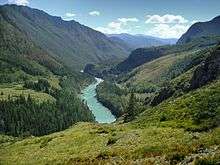
More than 20,000 tributaries sprawl throughout the mountainous Republic, making for a total of more than 60,000 kilometers (37,000 mi) worth of waterways. The republic's largest rivers are the Katun and the Biya, both of which originate in the mountains and flow northwards. The junction of the two rivers eventually forms the Ob River, one of the longest rivers in Siberia, which flows northward to the Arctic Ocean.
The source of the black Biya River is Lake Teletskoye, the region's largest lake located in an isolated area far south in the mountains. The emerald-colored Katun River has its source at the Gebler glacier, which is situated on the Republic's highest point, Mount Belukha. The Katun River, in particular, holds a religious significance for native Altaians, as well as for many Russians who live in the area, as Mount Belukha is known in Altai folklore to be the gateway to the mystical kingdom of Shambhala.[14]
The hydrographic network of the Republic also includes approximately 7,000 lakes, adding up to a total area of more than 700 km2 (270 sq mi). The largest lake is Lake Teletskoye, which is 80 km (50 mi) long and 5 kilometers (3.1 mi) wide, has an area of 230.8 square kilometers (89.1 sq mi), and has a maximum depth of 325 meters (1,066 ft). The mountain lakes of Altai contain enormous freshwater reserves of a very pure quality as a result of their distance from civilization.[15] Lake Teletskoye alone contains more than 40 cubic kilometers (9.6 cu mi) of very clear water.
Potential groundwater storage is evaluated at 22 million m³ per day, while the present use constitutes about 44,000 m³ per day.
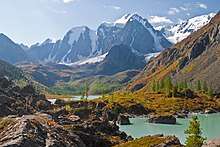
Mountains
The most striking geographical aspect of the Republic of Altai is its mountainous terrain. The Republic is situated within the Russian part of the Altai Mountains system, which covers a large part of the Republic and continues into neighboring Kazakhstan, Mongolia and China. The region continues to experience periodic notable seismic activity, which is visually made apparent through the mountains' characteristically high and rugged mountain ridges, separated by narrow and deep river valleys. The Republic's highest peak, Mount Belukha (4,506 m), is the highest point in Siberia.
Natural resources
Various bodies of water are among the most important natural resources of the Republic. Mineral and hot springs are popular destinations for tourists and locals, sought for their therapeutic effects. Additionally, Altai glaciers contain a great amount of fresh water. The general volume of ice for registered Altai glaciers comes to a total of 57 km³, 52 km³ of which is water. The total water stock of the glaciers exceeds the average annual effluence of all Altai rivers, which are equal to 43 km³ per year. The largest glaciers are Bolshoy Taldurinsky (35 km²), Mensu (21 km²), Sofiysky (17 km²), and Bolshoy Maashey (16 km²).
Mineral resources in the region primarily include gold, silver, iron ores, and lithium, in addition to other smaller amounts of minerals. The large city of Barnaul in neighboring Altai Krai was founded as a processing center for minerals from the Altai region, although the mineral extraction industry today is much smaller than in the past.
Climate
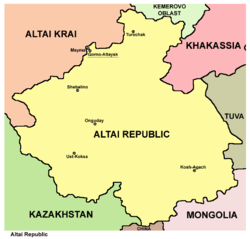
The republic has a temperate continental climate with relatively short and mild summers (June–August); and long, cold, and often quite frosty winters (November–March).
In general, the republic's climate of the southeastern areas, such as the (Ulagansky and Kosh-Agachsky Districts), is harsher than the climate of the less elevated northern areas.
- Average annual temperature: +1 °C to −6.7 °C.
- January temperature range: -9.2 °C to −31 °C.
- July temperature range: +11 °C to +19 °C.
- Average annual precipitation: 100–1000 mm.
Administrative divisions
The Altai Republic is administratively divided into ten districts and Gorno-Altaysk Urban Okrug. The districts are further subdivided into ninety-two rural settlements.
Demographics
Population: 206,168 (2010 Census);[6] 202,947 (2002 Census);[16] 191,649 (1989 Census).[17]
Vital statistics
| Average population (× 1000) | Live births | Deaths | Natural change | Crude birth rate (per 1000) | Crude death rate (per 1000) | Natural change (per 1000) | Fertility rates | |
|---|---|---|---|---|---|---|---|---|
| 1970 | 168 | 3,236 | 1,486 | 1,750 | 19.3 | 8.8 | 10.4 | |
| 1975 | 170 | 3,805 | 1,724 | 2,081 | 22.4 | 10.1 | 12.2 | |
| 1980 | 175 | 3,841 | 2,082 | 1,759 | 21.9 | 11.9 | 10.1 | |
| 1985 | 185 | 4,256 | 2,097 | 2,159 | 23.0 | 11.3 | 11.7 | |
| 1990 | 194 | 3,753 | 2,126 | 1,627 | 19.3 | 10.9 | 8.4 | 2,52 |
| 1991 | 196 | 3,579 | 2,064 | 1,515 | 18.2 | 10.5 | 7.7 | 2,41 |
| 1992 | 197 | 3,263 | 2,271 | 992 | 16.6 | 11.5 | 5.0 | 2,25 |
| 1993 | 197 | 2,878 | 2,630 | 248 | 14.6 | 13.4 | 1.3 | 2,00 |
| 1994 | 198 | 2,931 | 2,875 | 56 | 14.8 | 14.5 | 0.3 | 2,03 |
| 1995 | 199 | 2,853 | 2,637 | 216 | 14.3 | 13.2 | 1.1 | 1,93 |
| 1996 | 200 | 2,704 | 2,567 | 137 | 13.5 | 12.8 | 0.7 | 1,80 |
| 1997 | 200 | 2,686 | 2,547 | 139 | 13.4 | 12.7 | 0.7 | 1,77 |
| 1998 | 201 | 2,923 | 2,367 | 556 | 14.5 | 11.8 | 2.8 | 1,89 |
| 1999 | 202 | 2,742 | 2,536 | 206 | 13.6 | 12.6 | 1.0 | 1,74 |
| 2000 | 203 | 2,907 | 2,645 | 262 | 14.3 | 13.0 | 1.3 | 1,82 |
| 2001 | 203 | 3,033 | 2,870 | 163 | 14.9 | 14.1 | 0.8 | 1,87 |
| 2002 | 203 | 3,252 | 3,061 | 191 | 16.0 | 15.1 | 0.9 | 1,98 |
| 2003 | 203 | 3,392 | 3,173 | 219 | 16.7 | 15.7 | 1.1 | 2,04 |
| 2004 | 202 | 3,513 | 3,015 | 498 | 17.4 | 14.9 | 2.5 | 2,08 |
| 2005 | 202 | 3,502 | 3,170 | 332 | 17.3 | 15.7 | 1.6 | 2,03 |
| 2006 | 202 | 3,395 | 2,837 | 558 | 16.8 | 14.1 | 2.8 | 1,93 |
| 2007 | 202 | 4,066 | 2,574 | 1,492 | 20.1 | 12.7 | 7.4 | 2,29 |
| 2008 | 203 | 4,442 | 2,549 | 1,893 | 21.9 | 12.5 | 9.3 | 2,48 |
| 2009 | 204 | 4,266 | 2,492 | 1,774 | 20.9 | 12.2 | 8.7 | 2,48 |
| 2010 | 206 | 4,224 | 2,508 | 1,716 | 20.6 | 12.2 | 8.3 | 2,48 |
| 2011 | 207 | 4,719 | 2,529 | 2,190 | 22.7 | 12.2 | 10.5 | 2,84 |
| 2012 | 209 | 4,693 | 2,416 | 2,277 | 22.4 | 11.5 | 10.9 | 2,91 |
| 2013 | 211 | 4,442 | 2,392 | 2,027 | 21.1 | 11.3 | 9.8 | 2,82 |
| 2014 | 213 | 4,404 | 2,365 | 2,039 | 20.7 | 11.1 | 9.6 | 2,88 |
| 2015 | 214 | 4,022 | 2,347 | 1,675 | 18.7 | 10.9 | 7.8 | 2,68 |
| 2016 | 216 | 3,911 | 2,151 | 1,760 | 18.1 | 10.0 | 8.1 | 2,63(e) |
| 2017 | 217 | 3,443 | 2,099 | 1,344 | 15.8 | 9.6 | 6.2 |
Ethnic groups
As per the 2010 Census,[6] ethnic Russians make up 56.6% of the republic's population, with the indigenous Altai people making up 34.5%. Other groups include people of Kazakh (6.2%), and German (700 or 0.3%) ethnicity, together with smaller groups, each accounting for less than 0.5% of the total population.
| Ethnic group |
1926 Census | 1939 Census | 1959 Census | 1970 Census | 1979 Census | 1989 Census | 2002 Census | 2010 Census4 | ||||||||
|---|---|---|---|---|---|---|---|---|---|---|---|---|---|---|---|---|
| Number | % | Number | % | Number | % | Number | % | Number | % | Number | % | Number | % | Number | % | |
| Altay | 42,2131 | 42.4% | 39,285 | 24.2% | 38,019 | 24.2% | 46,750 | 27.8% | 50,203 | 29.2% | 59,130 | 31.0% | 68,0272 | 33.6% | 69,9633 | 34.5% |
| Russians | 51,813 | 52.0% | 114,209 | 70.4% | 109,661 | 69.8% | 110,442 | 65.6% | 108,795 | 63.2% | 115,188 | 60.4% | 116,510 | 57.5% | 114,802 | 56.6% |
| Kazakhs | 2,326 | 2.3% | 4,280 | 2.6% | 4,745 | 3.0% | 7,170 | 4.3% | 8,677 | 5.0% | 10,692 | 5.6% | 12,108 | 6.0% | 12,524 | 6.2% |
| Others | 3,309 | 3.3% | 4,405 | 2.7% | 4,736 | 3.0% | 3,899 | 2.3% | 4,365 | 2.5% | 5,821 | 3.1% | 5,914 | 2.9% | 5,447 | 2.7% |
- including 3,414 Telengits, 1,384 Kumandins and 344 Teleuts
- including 2,368 Telengits, 1,533 Tubalars, 931 Kumandins, 830 Chelkans, 141 Shors and 32 Teleuts
- including 3,648 Telengits, 1,891 Tubalars, 1,062 Kumandins, 1,113 Chelkans and 87 Shors
- 3,432 people were registered from administrative databases, and could not declare an ethnicity. It is estimated that the proportion of ethnicities in this group is the same as that of the declared group.[20]
Politics
The head of government in the Altai Republic is the Head of the Republic, popularly elected for a four-year term. As of 2019, the Head of the Republic is Oleg Khorokhordin, who succeeded Alexander Berdnikov in this post. The supreme legislative body of the republic is the State Assembly—El Kurultai, with 41 deputies popularly elected every four years. Igor Yaimov is the current Chairman of the State Assembly-El Kurultai from January 2002.
The Republic's Constitution was adopted on June 7, 1997.
Economy
The Altai Republic is a highly agricultural region. However, it does have some industry which includes foodstuffs, non-ferrous metallurgy, chemicals, gold mining, footwear, dairying, and timber. Tourism has also begun to make its mark on the economy, and a large number of new hotels and resorts catering towards "New Russians" have begun to appear.
Transportation
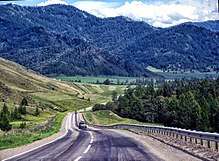
The Altai Republic is one of the few Russian political divisions without rail access. The main paved road is the Chuysky Tract, which spans the republic from the capital Gorno-Altaisk in the north to the Mongolian border in the south. The republic's main paved road threads its way through the rugged Altai Mountains. A system of taxis and buses transports people between settlements. Within the settlements, people generally walk or ride horses.
Helicopters are used for emergency transportation, to supply remote government outposts, and by wealthy tourists. In 2012, runway capacity at the Gorno-Altaysk Airport near the republic’s capital, was doubled. In June that same year, S7 Airlines started direct flights from Moscow. Prior to this, passengers used to fly through Barnaul in Altai Krai or Novosibirsk.[21]
Tourism
With the dissolution of the Soviet Union, the Altai Republic's tourism industry has greatly expanded. Although wealthy Russians from neighboring Russian regions are the most common sort of tourist in Altai, foreign interest has also grown in the area, especially due to the area's spiritual significance to New Age believers and others.
Popular tourist destinations tend to be concentrated in the north, where the roads are more accessible. They are also almost entirely located along the Chuiskiy highway, which is the main road from the north into the mountains (although it is currently only two lanes wide). The north is also significantly warmer than the elevated southern areas, which tend to be chilly even in the summer.
Some of the more well-known tourist spots in the Altai Republic include Lake Aiya (a popular bathing spot), and the picturesque Chemal region. More adventurous travelers may wish to visit the more remote Lake Teletskoye or Mount Belukha in the south.
Education
There is one university (Gorno-Altaisk State University), twelve colleges, and 205 secondary schools in the republic.
Religion
Different religions are present in Altai. According to a 2012 survey,[22] 27.6% of the population adheres to the Russian Orthodox Church. The second most popular religions are ethnic and nature religions, namely Rodnovery (Slavic native faith), Tengrism (Central Asians' native faith) and Burkhanism, constituting altogether 13% of the population. 6% of the population follows Islam, 2% Hinduism (including Slavic-Vedic, Krishnaite, and Tantric movements), 1% are Old Believers and 1% Protestants. 25% of the population is "spiritual but not religious", 14% is atheist and 7.4% follows other religions or did not answer the question.[22]
The traditional religion of the native Altaians is Tengrist shamanism, revived by modern Tengrist movements and Burkhanism. Ethnic Russians primarily practice Russian Orthodox Christianity and Rodnovery (Slavic native faith), but also Hinduism, while Kazakhs are traditionally Muslims. Tibetan Buddhism has also recently begun making some inroads by way of neighboring Mongolia and Tuva.
It is unknown when buddhism came into Altai but however, in various periods of history, the territory of the Altai and its population found themselves in full or partial subjection to neighboring states, where Buddhism was the official or one of the official religions: the state of the Khitans (tenth-twelfth centuries), the Mongol Empire (thirteenth-fourteenth centuries), and the Dzhungar Khanate (seventeenth-eighteenth centuries).[24]
From 1904 until the 1930s, a new religious movement called Burkhanism (or Ak Jang, the "white faith") was popularized among native Altaians. The religion originated in Altai and emphasized the "white" aspect of shamanistic practice. Burkhanism remains an important component of Altai national consciousness and is currently being revived in several forms along with indigenous Altai culture in general.
Russian Pagan and Hindu followers often go on pilgrimages to Mount Belukha, which is considered to be the location of Shambhala both by some Pagans and locals of Altai. One can often find manifestations of shamanistic spirituality in the region; for example, at points along the Katun River, local believers in shamanic religions are known to tie white ribbons to nearby trees and leave offerings of coins or food to the spirits.[25] Although shamanism is much less widely practiced today, it is regaining popularity as a result of new religious freedom following the collapse of the Soviet Union.
Culture
The indigenous Altai culture holds the lands of Altai to be sacred. The indigenous (Turkic) languages are focused on the stewardship of the lands. The Altai oral history is transmitted by throat-singers. The Altai culture was repressed during Soviet times and has been rebounding since then. The clans of all ten regions gather in the village of Yelo for a biennial cultural celebration.
There is also a large contingent of "Old Believers" who fled to Altai when they split from the Russian Orthodox Church over 300 years ago. They were taken in by the Altai people, and are now integrated into the fabric of Altai culture.
The UNESCO World Heritage Site "Golden Mountains" protects the Ukok Plateau, on which there are many standing stones and kurgans. Although archaeologists consider kurgans to be burial sites, the indigenous people believe that they are highly refined magnetic instruments for directing the flow of cosmic energy into the Earth. Thus, there is great local indignation about the excavation and removal of the Siberian Ice Maiden, an extraordinary 2,500-year-old mummy that had been preserved in permafrost.
Gorno-Altaisk is the location of the National Museum of the Altai Republic, which houses the mummy "Altai Princess", the National Library of the Republic of Altai, the National Theatre of the Republic of Altai and the Municipal House of Culture.
Regularly held national holiday Maslenitsa, Nowruz, Chaga – Bayram, received in February 2013 with the official status of the Republican celebration.
In 2013, the Altai Republic participated in the Turkvision Song Contest. The Altai Republic's entry was the song "Altayym Menin" performed by Artur Marlujokov. The Altai Republic won the fifth place in the contest.
Notable people
- Alexander Berdnikov (born April 8, 1953), Chairman of the Government of the Altai Republic, and the head of the republic from January 20, 2006.
- Grigory Gurkin (January 24, 1870 – October 11, 1937), landscape painter.
- Mikhail Lapshin (September 1, 1934 – June 17, 2006), President of the Altai Republic from January 19, 2002, to January 19, 2006.
- Sergey Mikayelyan (born April 27, 1992), cross-country skier.
- Viktor Shvaiko (b. 1965), painter.
- Semyon Zubakin (born May 4, 1952), Head of the Altai Republic in Russia from January 13, 1998, to January 19, 2002.
See also
- Music of Altai
- Altai-Sayan region
References
Citations
- Президент Российской Федерации. Указ №849 от 13 мая 2000 г. «О полномочном представителе Президента Российской Федерации в федеральном округе». Вступил в силу 13 мая 2000 г. Опубликован: "Собрание законодательства РФ", No. 20, ст. 2112, 15 мая 2000 г. (President of the Russian Federation. Decree #849 of May 13, 2000 On the Plenipotentiary Representative of the President of the Russian Federation in a Federal District. Effective as of May 13, 2000.).
- Госстандарт Российской Федерации. №ОК 024-95 27 декабря 1995 г. «Общероссийский классификатор экономических регионов. 2. Экономические районы», в ред. Изменения №5/2001 ОКЭР. (Gosstandart of the Russian Federation. #OK 024-95 December 27, 1995 Russian Classification of Economic Regions. 2. Economic Regions, as amended by the Amendment #5/2001 OKER. ).
- Constitution, Article 8
- Official website of the Altai Republic. Biography of Alexander Vasilyevich Berdnikov Archived 2011-07-17 at the Wayback Machine
- Федеральная служба государственной статистики (Federal State Statistics Service) (2004-05-21). "Территория, число районов, населённых пунктов и сельских администраций по субъектам Российской Федерации (Territory, Number of Districts, Inhabited Localities, and Rural Administration by Federal Subjects of the Russian Federation)". Всероссийская перепись населения 2002 года (All-Russia Population Census of 2002) (in Russian). Federal State Statistics Service. Retrieved 2011-11-01.
- Russian Federal State Statistics Service (2011). "Всероссийская перепись населения 2010 года. Том 1" [2010 All-Russian Population Census, vol. 1]. Всероссийская перепись населения 2010 года [2010 All-Russia Population Census] (in Russian). Federal State Statistics Service.
- "26. Численность постоянного населения Российской Федерации по муниципальным образованиям на 1 января 2018 года". Federal State Statistics Service. Retrieved 23 January 2019.
- "Об исчислении времени". Официальный интернет-портал правовой информации (in Russian). 3 June 2011. Retrieved 19 January 2019.
- Official throughout the Russian Federation according to Article 68.1 of the Constitution of Russia.
- Constitution, Article 13.
- Name used in internal passports according to law ПОСТАНОВЛЕНИЕ Правительства Республики Алтай от 17.07.2001 N 208 "О ТИПОВОМ ОБРАЗЦЕ БЛАНКА-ВКЛАДЫША РЕСПУБЛИКИ АЛТАЙ К БЛАНКУ ПАСПОРТА ГРАЖДАНИНА РОССИЙСКОЙ ФЕДЕРАЦИИ" Archived 2014-05-29 at the Wayback Machine
- Skutsch, Carl, ed. (2005). Encyclopedia of the World's Minorities. 1. New York: Routledge. p. 82. ISBN 1-57958-468-3.
- altaiassistanceproject.org https://web.archive.org/web/20081121190602/http://www.altaiassistanceproject.org/travelenmek.html. Archived from the original on November 21, 2008. Retrieved August 10, 2016.
This Page Is Under Construction – Coming Soon!
Missing or empty|title=(help) - "Archived copy". Archived from the original on 2007-01-01. Retrieved 2006-12-28.CS1 maint: archived copy as title (link)
- Russian Federal State Statistics Service (21 May 2004). "Численность населения России, субъектов Российской Федерации в составе федеральных округов, районов, городских поселений, сельских населённых пунктов – районных центров и сельских населённых пунктов с населением 3 тысячи и более человек" [Population of Russia, Its Federal Districts, Federal Subjects, Districts, Urban Localities, Rural Localities—Administrative Centers, and Rural Localities with Population of Over 3,000] (XLS). Всероссийская перепись населения 2002 года [All-Russia Population Census of 2002] (in Russian).
- "Всесоюзная перепись населения 1989 г. Численность наличного населения союзных и автономных республик, автономных областей и округов, краёв, областей, районов, городских поселений и сёл-райцентров" [All Union Population Census of 1989: Present Population of Union and Autonomous Republics, Autonomous Oblasts and Okrugs, Krais, Oblasts, Districts, Urban Settlements, and Villages Serving as District Administrative Centers]. Всесоюзная перепись населения 1989 года [All-Union Population Census of 1989] (in Russian). Институт демографии Национального исследовательского университета: Высшая школа экономики [Institute of Demography at the National Research University: Higher School of Economics]. 1989 – via Demoscope Weekly.
- БГД. Gks.ru. Retrieved on 2013-08-20.
- Каталог публикаций::Федеральная служба государственной статистики. Gks.ru (2010-05-08). Retrieved on 2013-08-20.
- Перепись-2010: русских становится больше. Perepis-2010.ru (2011-12-19). Retrieved on 2013-08-20.
- Altai Republic slowly opening up to outside world
- "Arena: Atlas of Religions and Nationalities in Russia". Sreda, 2012.
- 2012 Arena Atlas Religion Maps. "Ogonek", № 34 (5243), 27/08/2012. Retrieved 21/04/2017. Archived.
- Zhukovskaia, N. L. (2001-04-01). "Lamaism in the Altai". Anthropology & Archeology of Eurasia. 39 (4): 50–51. doi:10.2753/AAE1061-1959390450. ISSN 1061-1959.
- Archived September 5, 2006, at the Wayback Machine
- http://vk.com/club36551248
- https://translate.google.co.uk/translate?hl=sv&sl=ru&u=http://www.rusbandy.ru/&prev=search
Sources
- 7 июня 1997 г. «Конституция Республики Алтай (Основной Закон)», в ред. Конституционного закона №5-КРЗ от 27 ноября 2007 г. (June 7, 1997 Constitution of the Altai Republic (Basic Law), as amended by the Constitutional Law #5-KRZ of November 27, 2007. ).
External links
| Wikimedia Commons has media related to Altai Republic. |
| Wikivoyage has a travel guide for Altai_Republic. |
